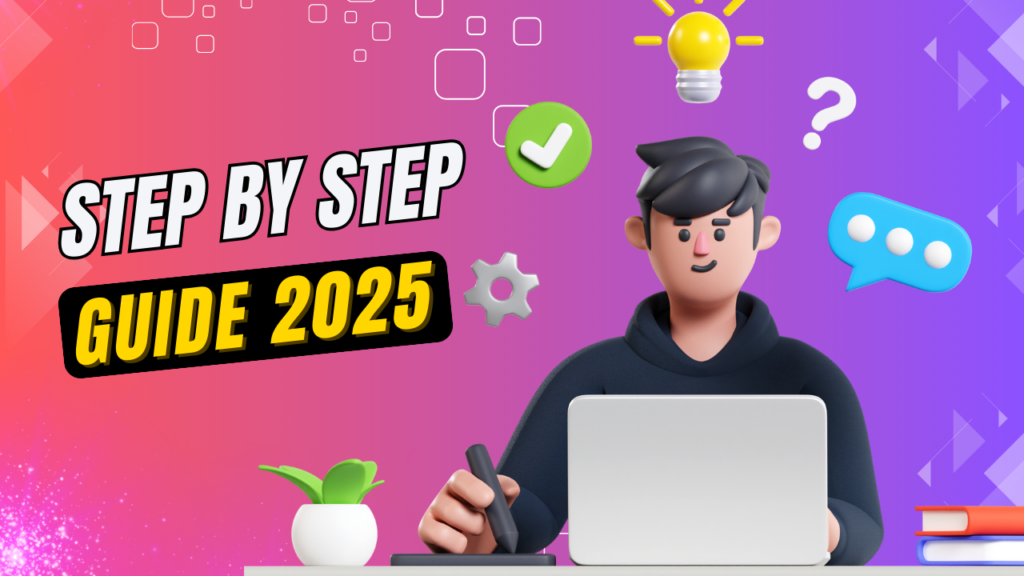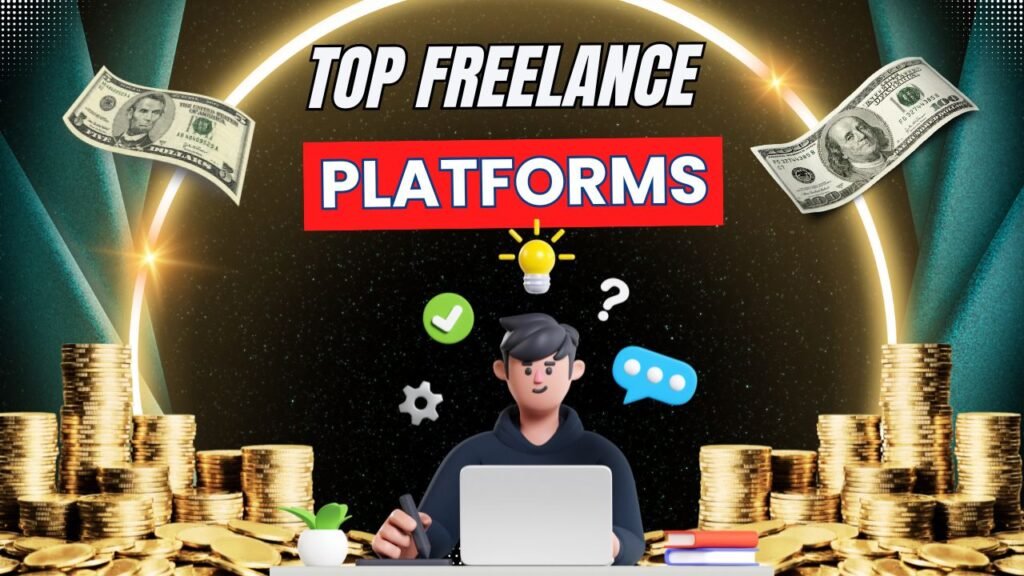Are you looking for an easy & step by step guide on how to start blogging in 2025?
This step by step guide will help you start your blogging journey in no time.
By the end of this guide, you will have a fully functional and beautiful blog that’s ready to share your ideas with the world.
You don’t need advanced technical skills or experience—just follow along, and we’ll show you exactly what to do, using clear instructions, visuals, and practical tips to make everything as simple as possible.
Let’s get started!
How to Start Blogging in 7 Steps?
- Choose Your Niche: Pick a topic you’re passionate about with audience potential.
- Select a Blogging Platform: WordPress is the recommended platform for flexibility and scalability.
- Pick a Domain and Hosting: Choose a relevant domain and reliable hosting, like Hostinger.
- Install WordPress: Use a one-click installation for quick setup.
- Create Content: Focus on valuable, SEO-optimized content for your audience.
- Monetize: Monetize your blog through affiliate marketing and ads.
- Promote & Grow: Use social media and SEO strategies to promote & grow your blog.
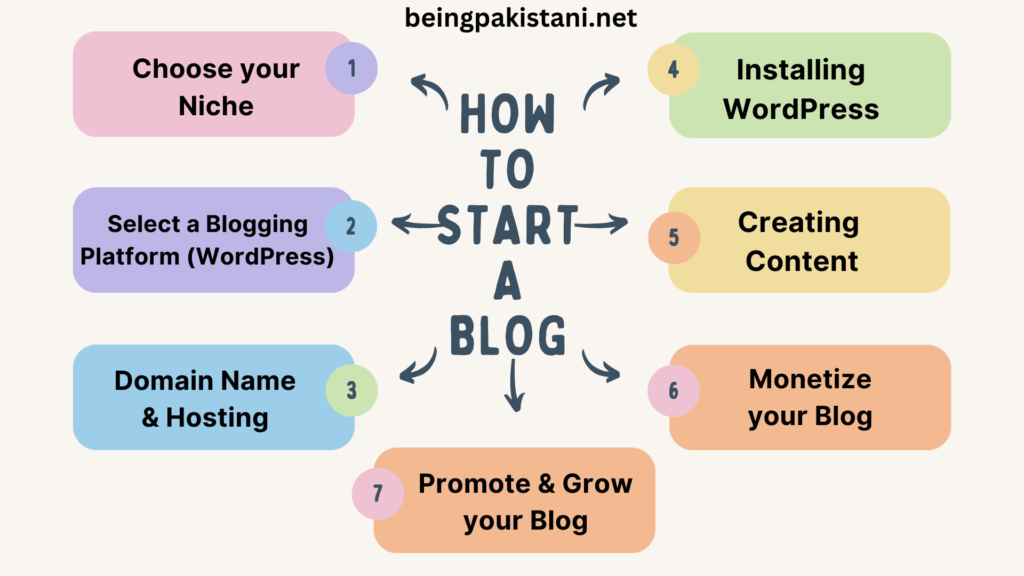
What is Blogging?
Blogging is the practice of sharing ideas, knowledge, and experiences through regularly updated online content.
It serves as a platform for individuals to express themselves, build communities, and influence public opinion.
In today’s digital age, blogs have become essential for personal branding, business marketing, and information dissemination.
Why Start Blogging in 2025?
In 2025, blogging is still relevant and with the access to right tools, you can automate your blogging process. In recent years, there has been a lot of innovation & growth in technology and AI.
This growth has led to a surge in digital content creation, making blogging an increasingly popular way for everyone to share their expertise, build online businesses, and generate income.
Blogging is more than a hobby; it’s a powerful tool for empowerment, allowing individuals to make their voices heard, promote local culture, and connect with a global audience.
Let’s start your blog.
Step 1: Choosing Your Niche
Before you start, you must select a niche. So, what is a niche?
A niche is a specific topic or area of interest that you focus on in your blog.
Understanding your audience will help you tailor your content to their needs and interests.
It helps you target a particular audience by addressing their specific needs or interests, making your content more relevant and engaging for them.
Popular Blogging Niches
Some of the popular blogging niches in Pakistan are
- Tech and Gadgets: With the growing interest in technology and smartphones in Pakistan, blogs focused on tech reviews, tutorials, and gadget comparisons are highly popular.
- Fashion and Beauty: Fashion and beauty blogs are in demand, especially those focusing on local trends, makeup tutorials, and product reviews.
- Food and Recipes: Food blogging is another lucrative niche, with many people searching for traditional Pakistani recipes, restaurant reviews, and culinary tips.
- Personal Finance and Investment: Personal finance blogs offering advice on savings, investments, and budgeting are gaining traction.
- Travel and Lifestyle: Travel blogs showcasing the beauty of Pakistan’s diverse landscapes and lifestyle blogs offering tips on daily living, culture, and local events are increasingly popular.
- Education and Career Advice: Education-related blogs, especially those offering career advice, exam preparation tips, and guidance on higher education, cater to a large audience of students and young professionals.
I have created a detailed guide on the most popular and profitable blogging niches in 2025.
So, now that you’ve selected your niche, it’s time to choose your blogging platform.
Step 2: Selecting a Blogging Platform
You can start the blogging for free by choosing blogger but I won’t recommend it. If you want to pursue the blogging as your career, you must start with WordPress.
Before we dive in further, you may want to check the Blogging Mistakes that must be avoided at all costs.
Some of the popular blogging platforms are:
- WordPress :The most popular blogging platform with easy to use interface and gives you flexibility to customize your blog the way you want.
- Blogger: A free platform owned by Google. It’s easy to use but lacks the advanced features and customization options of WordPress.
- Wix and Squarespace: These platforms offer drag-and-drop website builders, ideal for beginners who want simplicity but with limited scalability.
Why WordPress is Ideal for Bloggers
- Control and Ownership:
- With WordPress, you have full ownership of your content, unlike platforms like Blogger where your blog can be taken down by the host.
- Customization:
- WordPress offers a vast array of themes and plugins that allow you to customize your blog to fit your specific needs, whether it’s for monetization, SEO, or user engagement.
- Community and Support:
- WordPress has a large global community, with plenty of resources, tutorials, and forums where you can seek help.
- SEO-Friendly:
- WordPress is known for being SEO-friendly, with built-in features and plugins like Yoast SEO that help you optimize your content for search engines, making it easier to attract readers.
Now, that you have decided to go with the WordPress, and trust me, you made the right choice. It’s time to choose your blog name and hosting.
Step 3: Domain Name and Hosting
Before we dive in to the step by step process on how to install WordPress on the domain name you selected, you must read these tips on choosing the best name.
Tips for Choosing a Domain Name
- Keep it Short and Memorable:
- A concise domain name is easier to remember and type. Avoid long or complicated words that might be difficult for users to recall.
- Use Keywords:
- Incorporate relevant keywords related to your blog’s niche. This can help with SEO and make your blog more discoverable in search engines.
- Avoid Numbers and Hyphens:
- Numbers and hyphens can confuse users and lead to mistyped URLs. Stick to letters and easy-to-spell words.
- Check Availability and Trademarks:
- Ensure that your chosen domain name isn’t already in use or trademarked. Use domain search tools to check availability and avoid legal issues.
So, I am assuming you have selected the perfect domain name for your blog. It’s time to choose a host and start building your blog.
To start your blog, you need two essential components: web hosting and blogging software. Since, we already selected WordPress as our blogging platform, it’s time a choose a host.
A blog host is a service that stores all the files for your blog and makes them accessible to users when they type in your blog’s web address.
Without a hosting provider, your blog can’t be viewed online.
Now, you may be thinking, How do I know which hosting is best for my needs?
This video will help you make your decision.
Recommended Hosting Providers
- Hostinger:
- Offers affordable plans with good speed and reliability, making it a popular choice for bloggers in Pakistan.
- Inmotion Hosting:
- Known for excellent customer service and performance, particularly for small to medium-sized blogs.
- Namecheap:
- Provides competitive pricing with solid security features, ideal for beginners looking to start their blogging journey.
- Ultahost:
- A newer option with strong performance metrics, especially appealing for tech-savvy users in Pakistan.
- Dreamhost:
- Offers comprehensive plans with unlimited storage and bandwidth, suitable for bloggers who expect to scale their blog over time.
If you want to learn more, you can check this guide on the Best Hosting For WordPress in Pakistan.
I would highly recommend you to go with Hostinger.
Here’s why:
- Cheapest & Affordable: It offers some of the most affordable hosting plans, making it ideal for new bloggers looking to keep costs low without sacrificing quality.
- Fastest: With optimized servers and advanced caching, Hostinger provides fast loading times, ensuring a smooth experience for your blog visitors.
- Customer Support: Hostinger offers 24/7 customer support with a knowledgeable team that can help you with any issues or questions you may have.
- Easy-to-Use Interface: Hostinger’s user-friendly control panel makes managing your blog simple, even for beginners, allowing you to focus on creating content rather than technical details.
I have tried couple other hosts but it’s the only one I am satisfied with.
And the icing on the cake, I have got you a deal to get up to 80% off.
Once you click on it, it’ll take you directly to the website.

Choose your hosting plan and create the account by filling out your email and password.

Once you have filled out these, select the payment method and fill out the required fields.

As can you see, there’s a huge 80% discount that means you’re getting a free domain and very cheap hosting plan so make sure to signup using the link below.
Now, that you have purchased the hosting plan and got a free domain. It’s time to install WordPress and start working on your blog.
Step 4: Installing WordPress
Once the purchase is complete, log into your Hostinger account. Simple put the email and password you used when creating the account.

Once you’ve logged in, click on the manage button in front of your domain. Click on auto-installer.
Installing WordPress via hPanel’s Auto Installer is a quick and efficient method. Here’s a step-by-step guide:
In your hPanel, navigate to Website → Auto Installer and select WordPress from the list of applications.
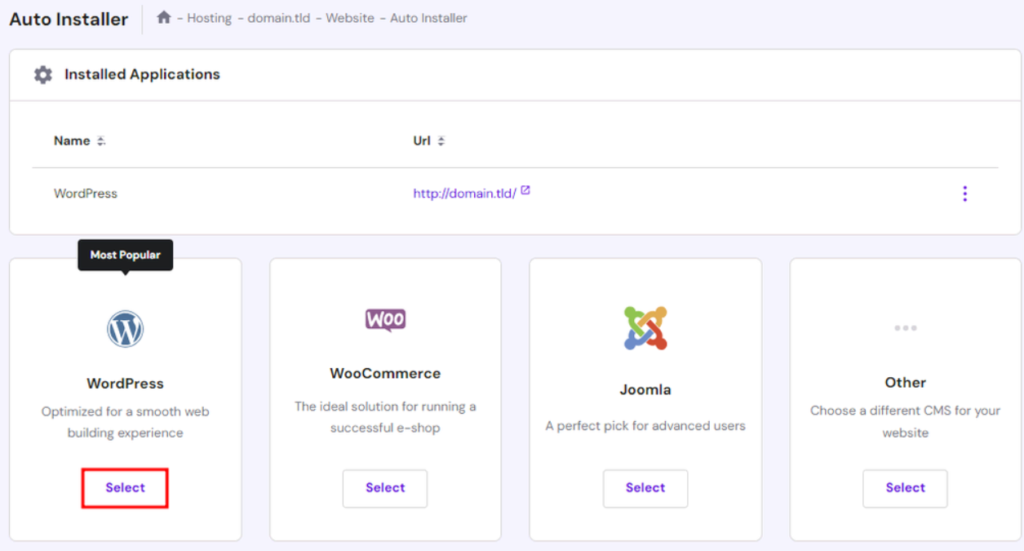
Set Up WordPress Credentials: Enter your site title, email address, username, and password for your WordPress admin account. Once done, click Next.

Configure Installation Settings: Select your preferred WordPress version, language, and update schedule and then click install.

Once you have installed the wordpress, it will take you to dashboard similar to this.
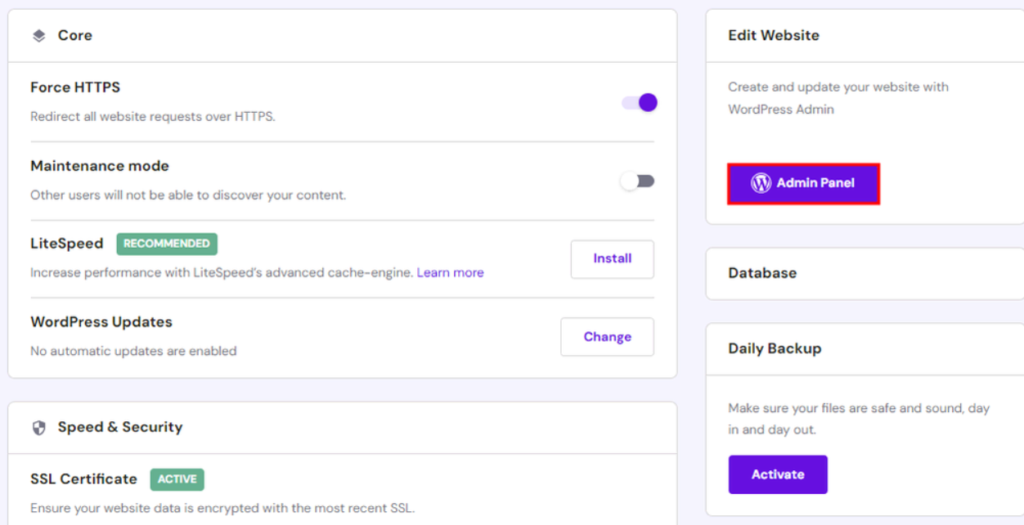
Click on the admin panel and it will direct you to WordPress dashboard.
Once you log into your WordPress account, you’ll land in the WordPress dashboard—the central hub where you can manage and customize your blog.
Here, you can make any changes to your site’s functionality, design, and content.
Everyone envisions their blog differently, and one of the standout features of WordPress is the ability to customize your entire blog layout easily. This is done through WordPress Themes.
Change Theme
A blog theme controls the entire design and layout of your WordPress blog, from colors and fonts to the overall structure of your pages. WordPress themes offer flexibility, allowing you to change the look and feel of your blog without altering its content.
To change your theme:
- In your WordPress dashboard, go to the left-hand menu and click on Appearance.
- Under Appearance, click on Themes.
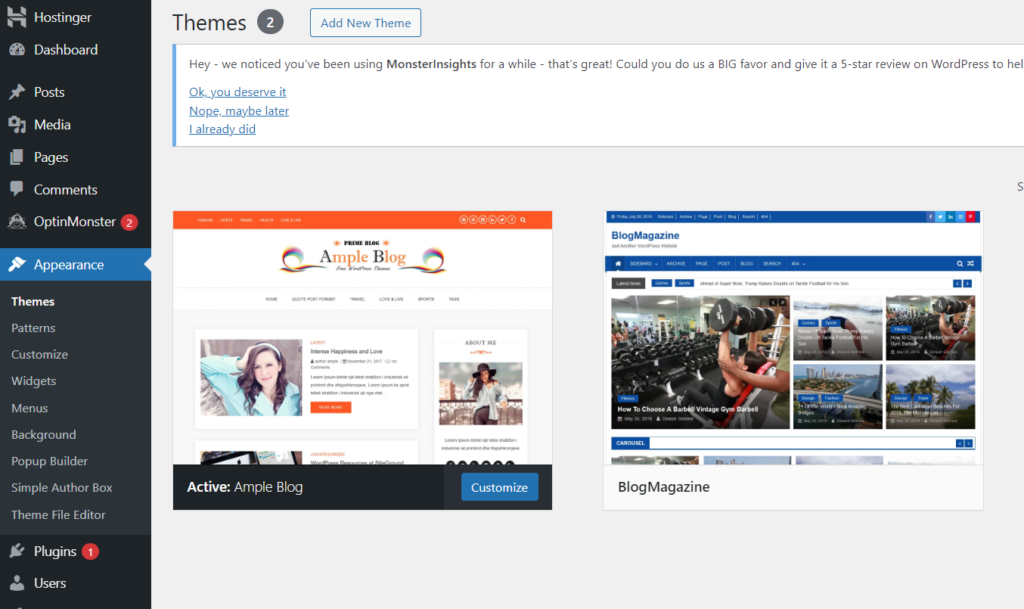
- Browse available themes or upload your own.
- Once you’ve chosen a theme, install then click Activate, and the design of your blog will instantly update.
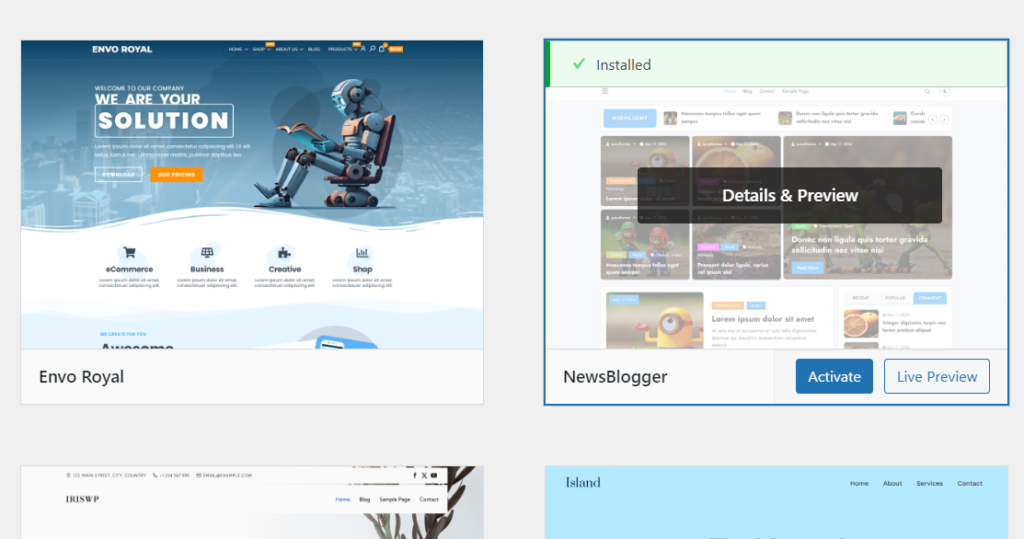
This easy customization feature is one of the reasons WordPress is so popular among bloggers.
Install Essential Plugins:
Install plugins to enhance your blog’s functionality. Essential plugins include Yoast SEO for search engine optimization, Akismet for spam protection, and Jetpack for performance and security.
Customize Your Blog:
Use the WordPress Customizer to tweak your blog’s appearance.
Go to Appearance and click customize.
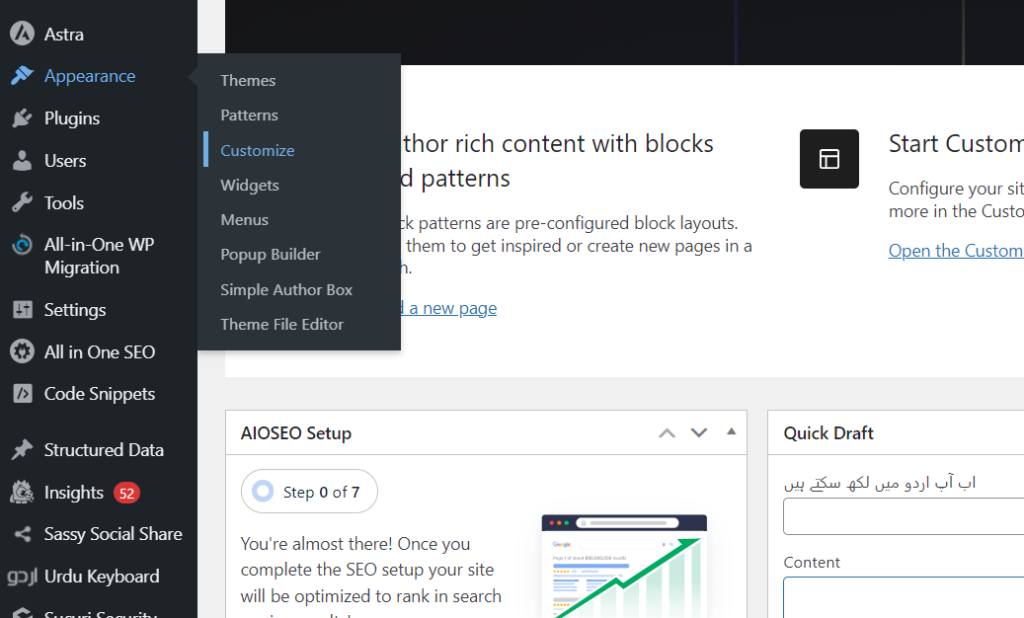
You’ll see a page like this. You can customize your theme fully.

Adjust the colors, fonts, and layout to create a cohesive brand identity.
Set up your blog’s navigation menu and add widgets as needed.
Create Important Pages:
Before launching your blog, create essential pages like About, Contact, Privacy Policy, and Terms of Service.
These pages help build trust with your audience and comply with legal requirements.
Now that everything looks good, it’s time for the next step which is create your first post.
Step 5: Creating Content
Now that your blog is up and running, it’s time to create your first piece of content! Here’s how you can write and publish your first blog post:
Step-by-Step Guide to Writing Your First Blog Post
Navigate to the “Posts” Section: From the WordPress dashboard, go to the left-hand menu and click on Posts.
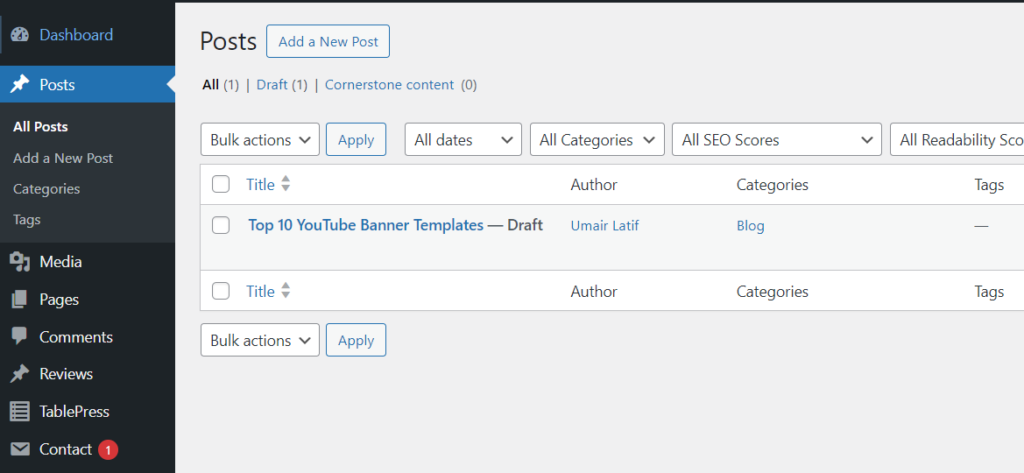
Delete the Default Post: You will notice a default post titled “Hello World” that comes with every new WordPress blog. To remove it, click on Trash just under the post.
Add a New Post: To start a new post, click the Add New button at the top or left of the “Posts” screen.
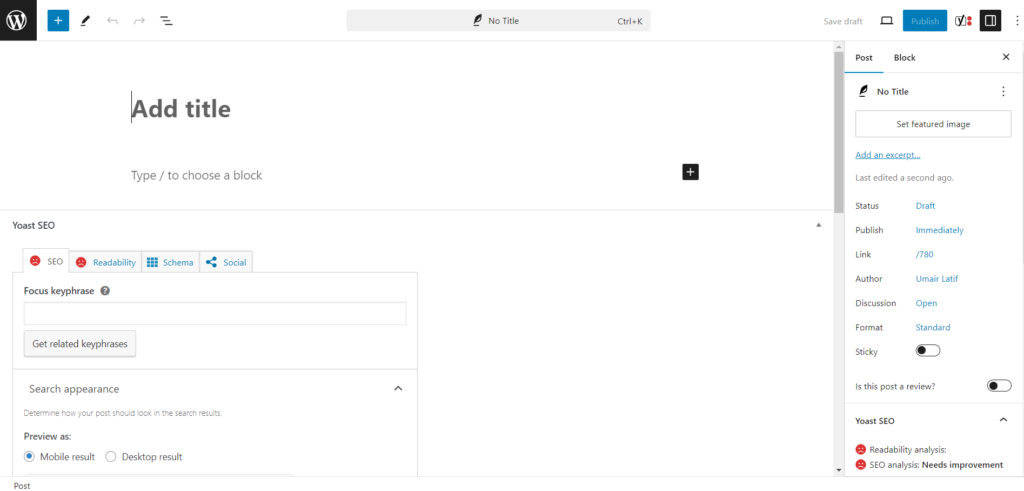
Write Your Post: You are now in the Post Editor. Enter the title of your post in the top field, and begin writing the content in the text box below.
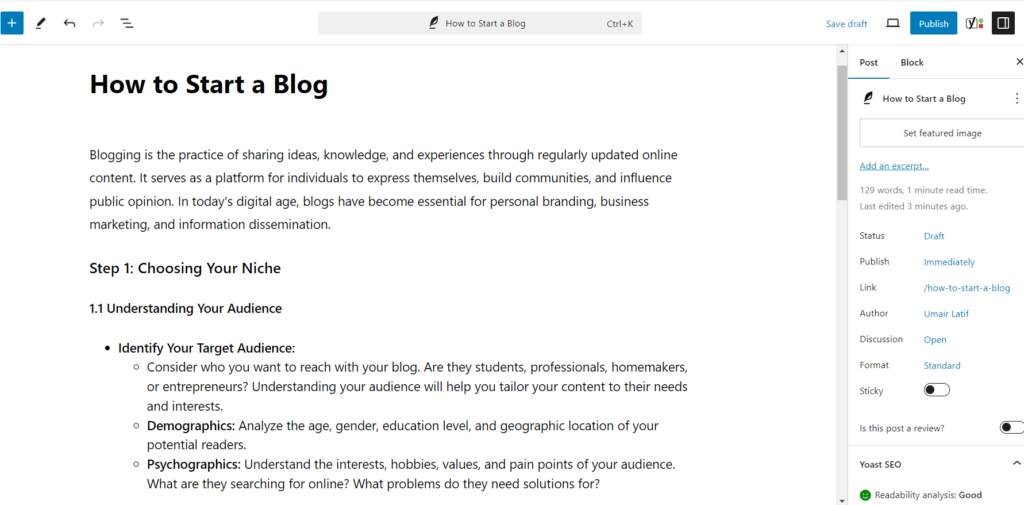
Publish Your Post: Once you’re happy with your content, click the Publish button located on the top-right side of the screen to make your post live on your blog.
SEO Best Practices
- Keyword Optimization:
- Use tools like Google Keyword Planner to find relevant keywords for your posts. Include these keywords in your title, headings, and throughout the content.
- On-Page SEO:
- Optimize your meta descriptions, use alt text for images, and ensure your URLs are clean and descriptive.
- Mobile Optimization:
- With many users in Pakistan accessing blogs via mobile devices, ensure your blog is mobile-friendly to enhance user experience and SEO rankings.
This structure will help you effectively design and create content for your blog, setting a solid foundation for attracting and retaining readers.
Step 6: Monetizing Your Blog
Monetizing your blog is an exciting step, but it requires strategic planning, patience, and a diversified approach to maximize revenue opportunities.
Here’s how you can get started with blog monetization.
Setting Realistic Expectations:
- Patience is Key: Blog monetization takes time, especially when you’re just starting. Before expecting substantial income, you’ll need to build a solid foundation, which includes high-quality content, steady traffic, and a loyal audience. The first few months (or even the first year) might not generate significant revenue, as your focus will likely be on growing your blog’s visibility and trustworthiness.
- Loyal Audience is Crucial: The more loyal and engaged your audience is, the easier it becomes to monetize. Building a relationship with your readers through valuable content and consistent communication makes them more likely to click on ads, purchase products, or subscribe to paid services.
Diversifying Income Streams:
Don’t Depend on One Method: To maximize your blog’s earning potential, it’s essential to explore and use various monetization strategies.
Relying solely on one income stream, like ads, limits your revenue opportunities and makes your income vulnerable to fluctuations. By diversifying, you can create multiple avenues for consistent earnings.
Some of the most common ways to monetize a blog include:
- Advertising: Join ad networks like Google AdSense to display ads on your site and earn money from clicks or impressions.
- Affiliate Marketing: Promote products or services relevant to your blog’s niche and earn commissions for every sale made through your referral links.
- Sponsored Posts: Collaborate with brands to create content that promotes their products or services in exchange for payment.
- Selling Digital Products: Create and sell eBooks, online courses, printables, or other digital products that align with your niche and audience interests.
- Offering Services: If you have a skill set related to your blog’s topic (e.g., writing, consulting, design), offer services directly to your audience.
- Memberships or Subscriptions: Offer exclusive content or perks to readers who pay for a subscription, creating a consistent monthly income stream.
- Donations or Crowdfunding: Use platforms like Patreon or Ko-fi to allow readers to support your blog financially through donations.
By setting realistic expectations and exploring multiple monetization strategies, you can create a sustainable income from your blog over time.
Step 7: Promote & Grow your Blog
Creating a well-designed blog and writing high-quality content is just the beginning of your blogging journey.
To attract visitors, especially when you’re starting out, you’ll need to invest time in promoting your blog.
Effective promotion helps get your blog in front of more readers and increases your chances of building an audience.
Here are some strategies you can try to increase your blog traffic:
- Share on Social Media: Post your blog content on platforms like Facebook, Twitter, Instagram, and LinkedIn. Social media helps drive traffic and allows you to engage with your audience.
- Leverage SEO (Search Engine Optimization): Use SEO best practices like targeting relevant keywords, optimizing meta tags, and creating high-quality backlinks to improve your blog’s search engine rankings and attract organic traffic.
- Join Blogging Communities: Engage with blogging forums, Facebook groups, or platforms like Reddit and Quora. These communities allow you to share your content and connect with like-minded individuals.
- Guest Blogging: Write guest posts for other blogs in your niche. This will help you tap into a new audience, build backlinks, and establish your authority.
- Build an Email List: Use email marketing to keep in touch with your readers and notify them of new blog posts. Building an email list allows you to create a loyal community around your content.
- Collaborate with Other Bloggers: Partner with bloggers or influencers for collaborations, such as interviews, co-written posts, or content swaps. This can introduce your blog to their audiences.
- Use Paid Advertising: Consider running paid ads on platforms like Google Ads or social media to reach a targeted audience and drive traffic to your blog.
Remember, you don’t need to implement every strategy. Start with a few and see which methods work best for you!
I have created this in-depth guide on the Unique Strategies to grow your blog traffic from 0 to 10K in a single month.
Maintaining and Growing Your Blog
Once your blog is up and running, maintaining its quality and continually growing your audience is key to long-term success. Below are essential steps to ensure consistent growth and sustained engagement with your readers.
Regular Content Updates and SEO
Consistent Posting Schedule:
- Keep Your Audience Engaged: Publishing new content regularly keeps your audience returning for more and helps attract new readers. Whether you post weekly, bi-weekly, or monthly, consistency is key. A consistent schedule not only builds reader trust but also signals to search engines that your blog is active, improving your site’s rankings.
- Plan Your Content: Create a content calendar to organize your posts and ensure you always have fresh material ready to go. This approach helps you stay organized and meet your publishing goals.
SEO Optimization:
- Update and Refresh Content: SEO is not a one-time activity. Continuously update older posts with new, relevant keywords and optimize them for search engines. This can include refreshing headlines, improving meta descriptions, and adding internal links to newer content.
- Mobile Optimization: Ensure your blog posts are mobile-friendly, as mobile traffic continues to grow. Search engines prioritize mobile-friendly websites, which will help your blog rank higher in search results.
- Optimize for Long-Tail Keywords: Use keyword research tools to find long-tail keywords and incorporate them into your posts to attract targeted traffic.
If you’re new to seo, you may want to check out this Ultimate Guide on SEO for beginners. It has everything you need to know about SEO in 2025.
Analytics and Performance Tracking
Using Google Analytics:
- Track Key Metrics: Use Google Analytics to monitor important performance indicators like page views, average session duration, bounce rate, and user demographics. This data provides valuable insights into which content resonates with your audience and which areas need improvement.
- Audience Behavior: Analyze user behavior to understand how visitors are interacting with your site. Identify which posts are performing well and replicate their success in future content.
A/B Testing:
- Optimize Your Content: Experiment with A/B testing by creating two versions of the same content, with small variations such as different headlines, calls-to-action, or layouts. This helps you determine what works best for your audience and refine your approach.
- Data-Driven Decisions: Use the results from A/B tests to make informed changes to your content strategy, improving engagement and conversion rates.
Future Trends in Blogging for 2025
AI and Content Creation:
- Leverage AI Tools: The rise of AI tools is transforming content creation. AI-powered tools like content generators, grammar checkers, and SEO optimizers can assist in producing high-quality blog posts more efficiently. These tools can help you generate ideas, streamline editing, and ensure that your content is optimized for search engines.
- Personalized Content with AI: AI also enables you to create personalized content for your readers, improving user experience and engagement by delivering content tailored to their preferences.
Video and Visual Content:
- Increase Visual Engagement: As visual content continues to dominate online engagement, incorporating videos, infographics, and other visual elements into your blog will help you capture and retain audience attention. Videos are particularly effective for tutorials, product reviews, and engaging storytelling.
- YouTube and Blog Integration: Consider embedding YouTube videos into your blog posts to enhance content richness and improve time spent on the page.
Voice Search Optimization:
- Adapt to Voice Search Trends: With the growing use of voice search tools like Siri, Google Assistant, and Alexa, optimizing your content for voice search is becoming essential. Focus on conversational keywords and create content that answers specific questions, as these are common search queries for voice users.
- Long-Tail Keywords and Phrasing: Optimize your content by using question-based, natural language phrases that reflect how people speak when using voice search.
Final Thoughts:
Maintaining and growing your blog requires consistent effort and adaptation to changing trends. By regularly updating your content, optimizing for SEO, tracking your performance, and leveraging future trends like AI, visual content, and voice search, you can ensure your blog remains relevant and continues to attract and engage a growing audience.
FAQs
1. How much does it cost to start a blog?
- Starting a blog can be relatively inexpensive. If you choose a self-hosted WordPress site, you’ll need to budget for a domain name (around 10 -14USD per year) and hosting (starting at 2.99 USD per Month if choose hostinger). Optional costs include premium themes and plugins.
2. Is blogging profitable in 2025?
- Yes, blogging can be profitable if done correctly. Monetization methods such as affiliate marketing, sponsored posts, and ad revenue can generate income. However, building a profitable blog requires time, consistent effort, and strategic promotion.
3. Do I need technical skills to start a blog?
- No advanced technical skills are required to start a blog, especially if you use WordPress. Many hosting providers offer one-click installations, and WordPress itself is user-friendly. However, basic knowledge of website management and SEO will be helpful.
4. What content should I create for my blog?
- Focus on content that resonates with your target audience. Start with topics related to your niche and consider what problems or questions your readers might have. Consistency and quality are key to building an engaged audience.
5. How long does it take to see results from blogging?
- It varies, but typically, it can take several months to start seeing significant traffic and income from your blog. Success in blogging depends on your niche, content quality, promotion efforts, and consistency. Patience and persistence are crucial.
6. How can I start my own blog?
- To start your own blog, choose a niche, select a blogging platform like WordPress, purchase a domain name and hosting, design your blog, create content, and promote it through social media and other channels. Follow the detailed steps in the guide above.
7. How do I start a blog with no money?
- You can start a blog for free using platforms like WordPress.com or Blogger. These platforms offer free hosting and domain options, though with limited customization. As your blog grows, you can invest in a custom domain and premium features to enhance your blog’s professionalism and functionality.


